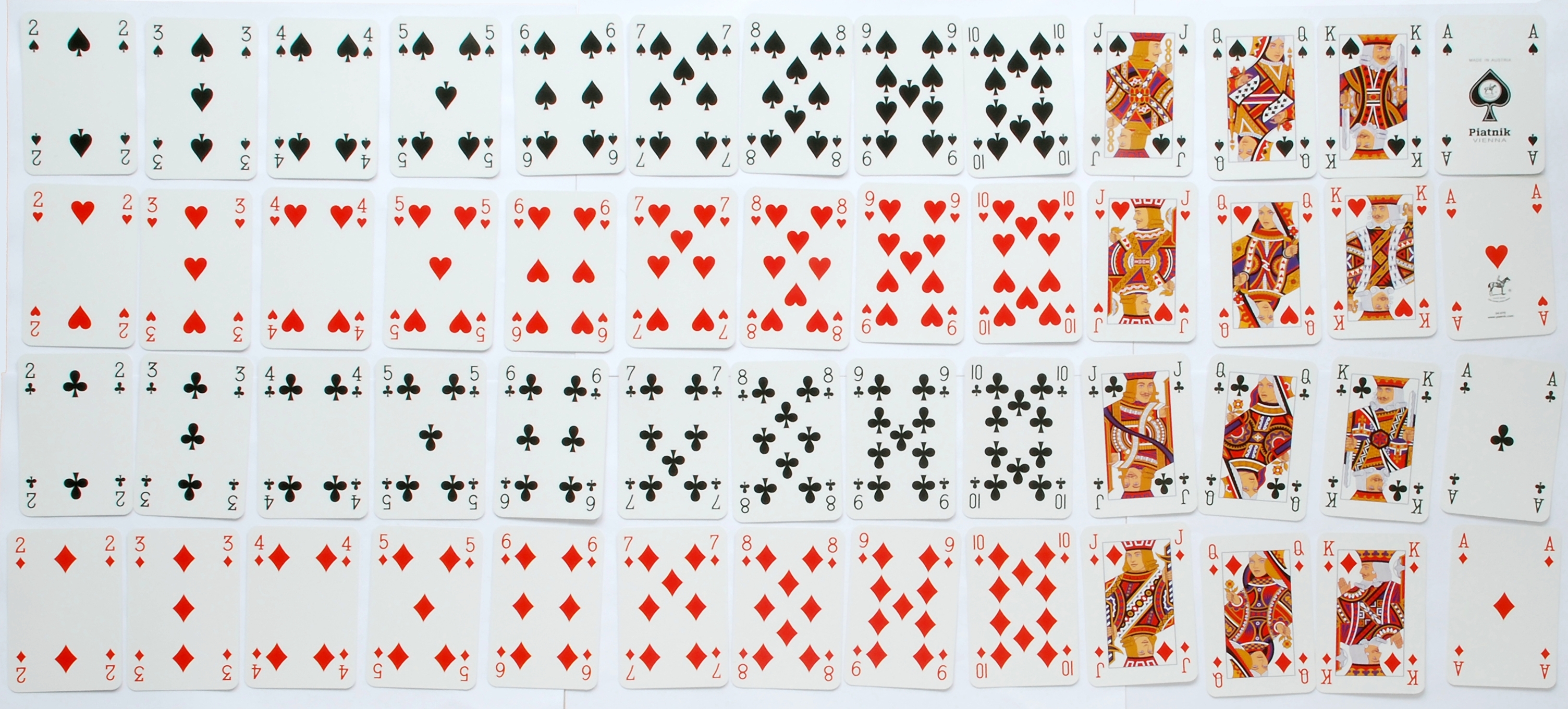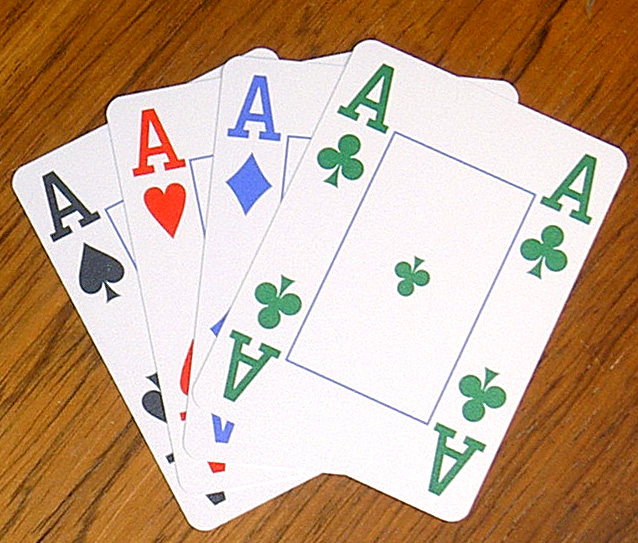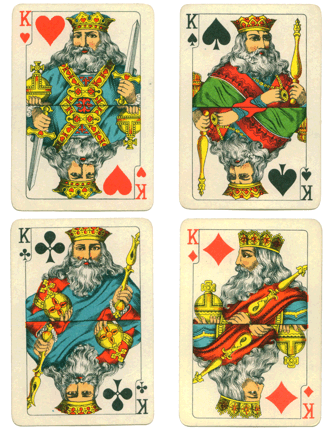|
Spades (suit)
Spades () () is one of the four playing card suits in the standard French-suited playing cards. It has the same shape as the leaf symbol in German-suited playing cards but its appearance is more akin to that of an upside down black heart with a stalk at its base. It symbolises the pike or halberd, two medieval weapons, but is actually an adaptation of the German suit symbol of Leaves created when French suits were invented around 1480.Dummett (1980), p. 22. In bridge, spades rank as the highest suit. In skat and similar games, it is the second-highest suit. Name The word "Spade" is probably derived from the Old Spanish ''spada'' meaning "sword" and suggests that Spanish suits were used in England before French suits. The French name for this suit, ("pike"), meant, in the 14th century, a weapon formed by an iron spike placed at the end of a pike. In German it is known as . It corresponds to the suit of leaves (, , or, in Bavaria, ) in the German-suited playing cards. In S ... [...More Info...] [...Related Items...] OR: [Wikipedia] [Google] [Baidu] |
French-suited Playing Cards
French-suited playing cards or French-suited cards are playing cards, cards that use the French Playing card suit, suits of (clovers or clubs ), (tiles or diamonds ), (hearts ), and (pikes or spades ). Each suit contains three or four face cards, face/court cards. In a standard 52-card deck these are the (jack (playing card), knave or jack), the (queen (playing card), lady or queen), and the (king (playing card), king). In addition, in Tarot packs, there is a (Knight (playing card), knight) ranking between the queen and the jack. Aside from these aspects, decks can include a wide variety of regional and national patterns, which often have stripped deck, different deck sizes. In comparison to Spanish playing cards, Spanish, Italian playing cards, Italian, German playing cards, German, and Swiss playing cards, French cards are the most widespread due to the geopolitical, commercial, and cultural influence of France, the United Kingdom, and the United States ... [...More Info...] [...Related Items...] OR: [Wikipedia] [Google] [Baidu] |
Clubs (suit)
Clubs () () is one of the four playing card suits in the standard French-suited playing cards. The symbol was derived from that of the suit of Acorns (suit), Acorns in a German-suited playing cards, German deck when French suits were invented, around 1480. In Skat (card game), Skat and Doppelkopf, Clubs are the highest-ranked suit (whereas Diamonds (suit), Diamonds and Bells (suit), Bells are the trump suit in Doppelkopf). In Contract bridge, Bridge, Clubs are the lowest suit. Name Its original French language, French name is which means "clover" and the card symbol depicts a three-leafed clover leaf. The Italian language, Italian name is ("flower"). However, the English language, English name "Clubs" is a translation of ''basto'', the Spanish name for the suit of batons (suit), batons, suggesting that Spanish-suited cards were used in England before French suits were invented. In Germany, this suit is known as ("cross"), especially in the International Skat (card game), Ska ... [...More Info...] [...Related Items...] OR: [Wikipedia] [Google] [Baidu] |
Seven Of Spades
Spades () () is one of the four playing card suits in the standard French-suited playing cards. It has the same shape as the leaf symbol in German-suited playing cards but its appearance is more akin to that of an upside down black heart with a stalk at its base. It symbolises the pike or halberd, two medieval weapons, but is actually an adaptation of the German suit symbol of Leaves created when French suits were invented around 1480.Dummett (1980), p. 22. In bridge, spades rank as the highest suit. In skat and similar games, it is the second-highest suit. Name The word "Spade" is probably derived from the Old Spanish ''spada'' meaning "sword" and suggests that Spanish suits were used in England before French suits. The French name for this suit, ("pike"), meant, in the 14th century, a weapon formed by an iron spike placed at the end of a pike. In German it is known as . It corresponds to the suit of leaves (, , or, in Bavaria, ) in the German-suited playing cards. In S ... [...More Info...] [...Related Items...] OR: [Wikipedia] [Google] [Baidu] |
Six Of Spades
The standard 52-card deck of French-suited playing cards is the most common pack of playing cards used today. The main feature of most playing card decks that empower their use in diverse games and other activities is their double-sided design, where one side, usually bearing a colourful or complex pattern, is exactly identical on all playing cards, thus ensuring the anonymity and fungibility of the cards when their value is to be kept secret, and a second side, that, when apparent, is unique to every individual card in a deck, usually bearing a suit as well as an alphanumerical value, which may be used to distinguish the card in game mechanics. In English-speaking countries it is the only traditional pack used for playing cards; in many countries, however, it is used alongside other traditional, often older, standard packs with different suit systems such as those with German-, Italian-, Spanish- or Swiss suits. The most common pattern of French-suited cards worldwide and the o ... [...More Info...] [...Related Items...] OR: [Wikipedia] [Google] [Baidu] |
Four Of Spades
Spades () () is one of the four playing card suits in the standard French-suited playing cards. It has the same shape as the leaf symbol in German-suited playing cards but its appearance is more akin to that of an upside down black heart with a stalk at its base. It symbolises the pike or halberd, two medieval weapons, but is actually an adaptation of the German suit symbol of Leaves created when French suits were invented around 1480.Dummett (1980), p. 22. In bridge, spades rank as the highest suit. In skat and similar games, it is the second-highest suit. Name The word "Spade" is probably derived from the Old Spanish ''spada'' meaning "sword" and suggests that Spanish suits were used in England before French suits. The French name for this suit, ("pike"), meant, in the 14th century, a weapon formed by an iron spike placed at the end of a pike. In German it is known as . It corresponds to the suit of leaves (, , or, in Bavaria, ) in the German-suited playing cards. In S ... [...More Info...] [...Related Items...] OR: [Wikipedia] [Google] [Baidu] |
Three Of Spades
The standard 52-card deck of French-suited playing cards is the most common pack of playing cards used today. The main feature of most playing card decks that empower their use in diverse games and other activities is their double-sided design, where one side, usually bearing a colourful or complex pattern, is exactly identical on all playing cards, thus ensuring the anonymity and fungibility of the cards when their value is to be kept secret, and a second side, that, when apparent, is unique to every individual card in a deck, usually bearing a suit as well as an alphanumerical value, which may be used to distinguish the card in game mechanics. In English-speaking world, English-speaking countries it is the only traditional pack used for playing cards; in many countries, however, it is used alongside other traditional, often older, standard packs with different suit systems such as those with German-suited cards, German-, Italian-suited cards, Italian-, Spanish-suited cards, Spanis ... [...More Info...] [...Related Items...] OR: [Wikipedia] [Google] [Baidu] |




